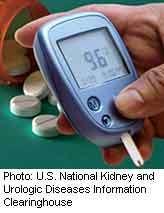Many people with type 1 diabetes missing treatment goals: study

(HealthDay) -- Many Americans with type 1 diabetes fail to meet their treatment targets, according to researchers who analyzed data from a newly created registry that includes more than 25,000 patients at 67 clinics nationwide.
The examination of data from the T1D Exchange Clinic Registry also found that many adult patients are overweight or obese and that many young patients have difficulty reaching target hemoglobin A1C levels, even under the best of circumstances. A1C level is a measurement of blood sugar control over a period of several months.
The findings from five separate analyses were presented Saturday at an American Diabetes Association (ADA) meeting.
In type 1 diabetes, the body does not produce insulin, a hormone that breaks down sugar and starch from food. People with this type of diabetes need to take regular insulin treatments. It's usually diagnosed in children and young adults, and occurs in about 5 percent of all diabetes cases, according to the ADA.
Despite advances in diabetes care, the data revealed that most people with type 1 diabetes in the United States still fail to meet treatment targets established by the association. The researchers found that a majority of adults with type 1 diabetes were overweight or obese with blood sugar levels in the elevated range (an A1C averaging from 7.5 percent to 8 percent).
Older adults (over age 50) had the lowest average A1C of all age groups (7.6 percent), but they also had a high percentage -- 14 percent to 20 percent per year -- of severe hypoglycemia (low blood sugar).
Hypoglycemia can be a side effect of many diabetes treatments. If not treated quickly, severe hypoglycemia can lead to seizure, coma and emergency department visits.
Among the other findings:
- Twenty percent to 30 percent of patients over age 40 have diabetes-related complications.
- The A1C average was 8.3 percent for those under age 12 and 8.7 percent for those aged 13-17.
- Blacks had higher average A1C levels than whites.
- In both youngsters and adults, lower A1C levels were associated with more frequent self-monitoring of blood sugar levels, less insulin resistance and greater use of newer technologies such as insulin pumps and continuous glucose monitoring.
- In adults, lower A1C levels were also associated with being marred and higher income. In youth, lower A1C levels were also associated with younger age, being white and having parents with a higher income, education and private health insurance.
"This is the first time we've ever been able to get a really clear picture of how people with type 1 diabetes are faring in the United States," Dr. Richard Bergenstal, executive director of the International Diabetes Center and vice chair of the T1D Exchange, said in an ADA news release.
"Now we finally have large enough numbers of patients collecting common data to know where we are getting it right and where we need to target our efforts for improvement in treatment and care," he added.
Because this research was presented at a medical meeting, the data and conclusions should be viewed as preliminary until published in a peer-reviewed journal.
More information: The Nemours Foundation has more about type 1 diabetes.
Copyright © 2012 HealthDay. All rights reserved.
















